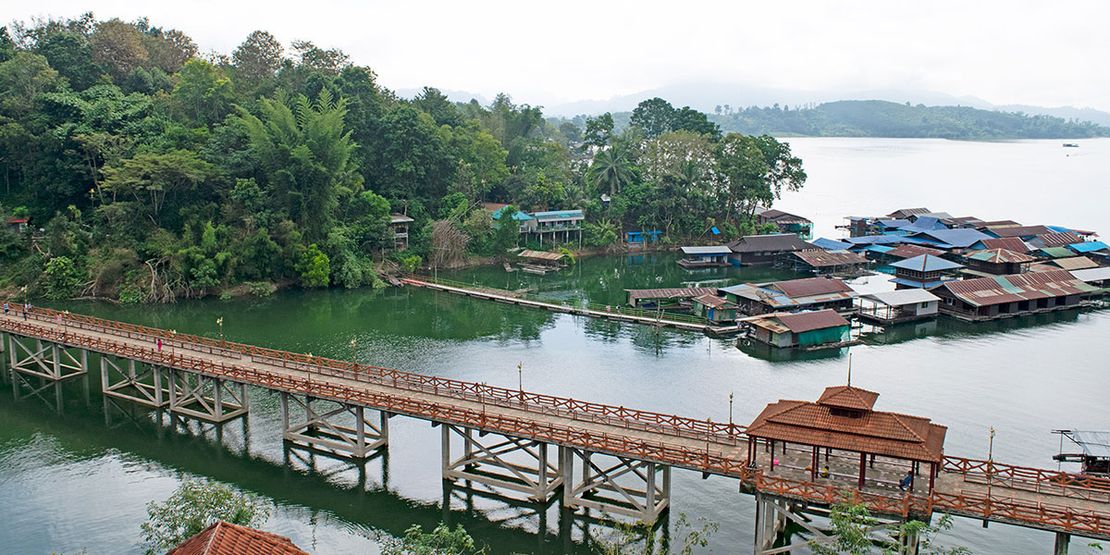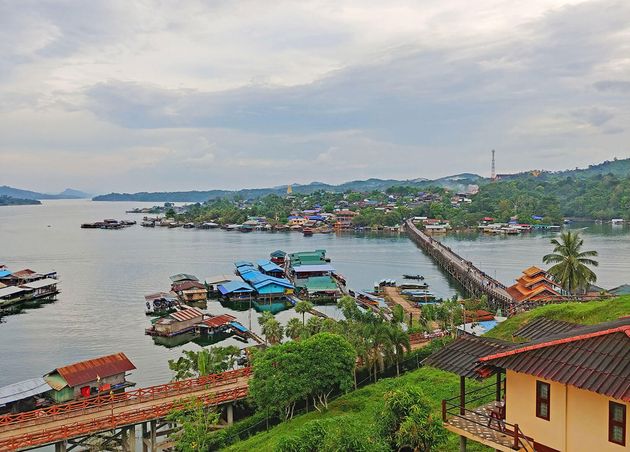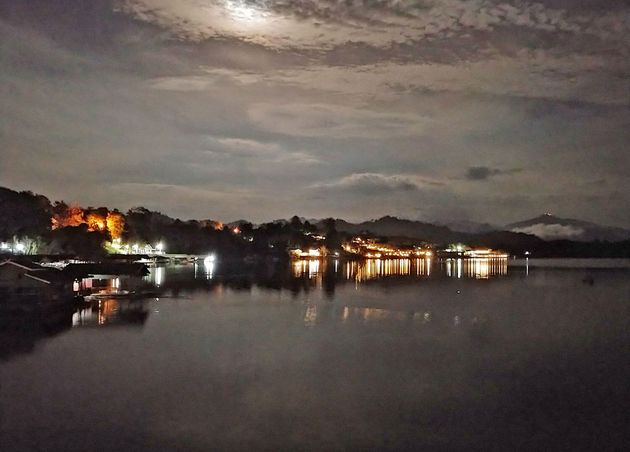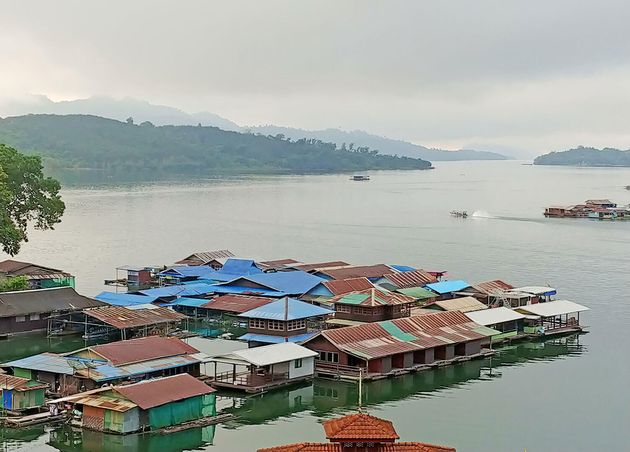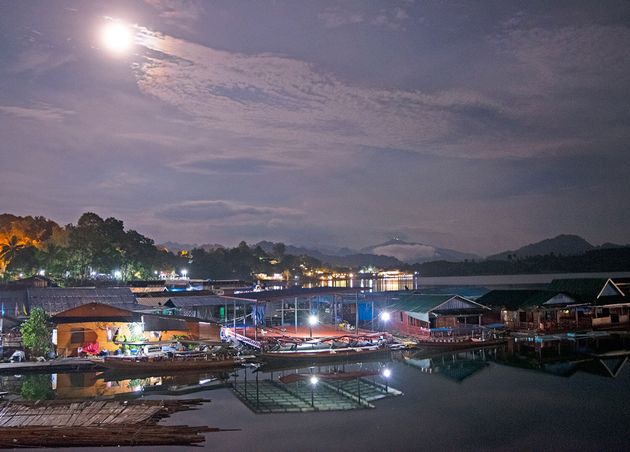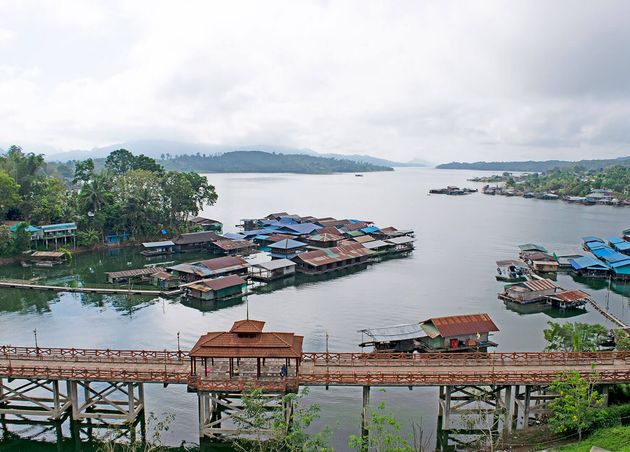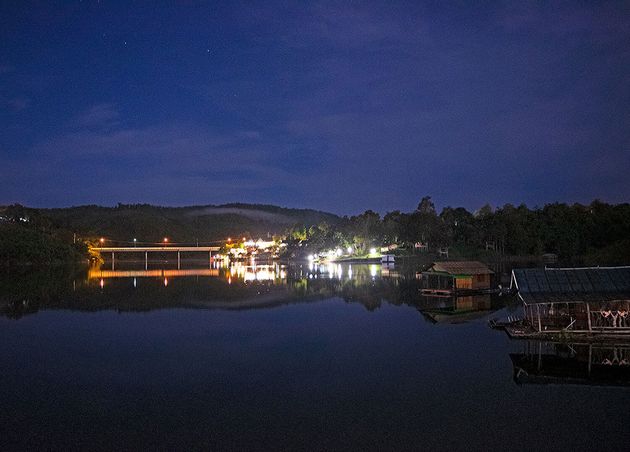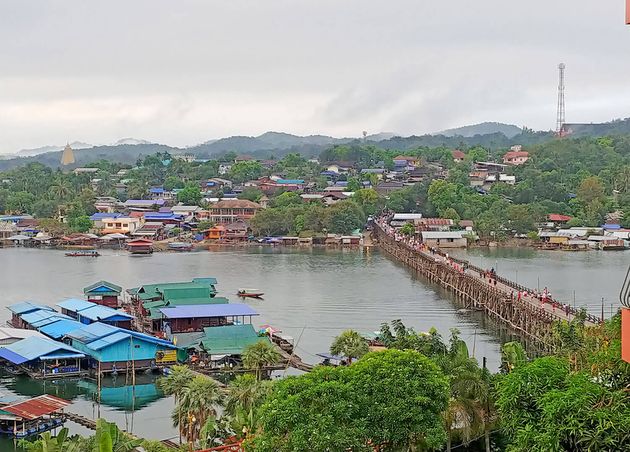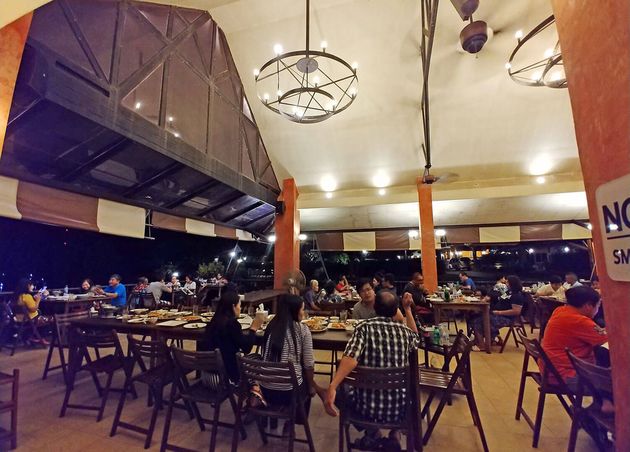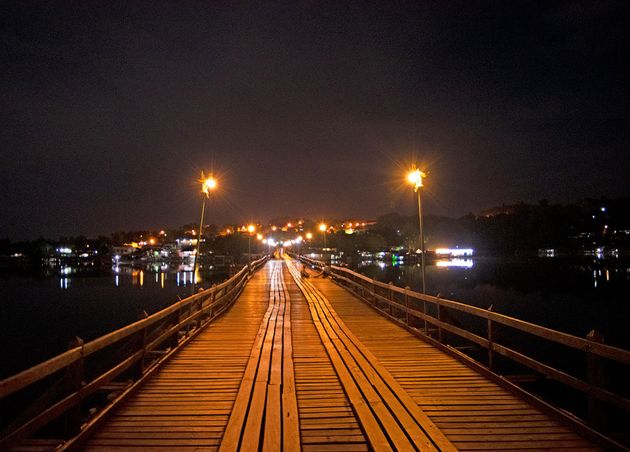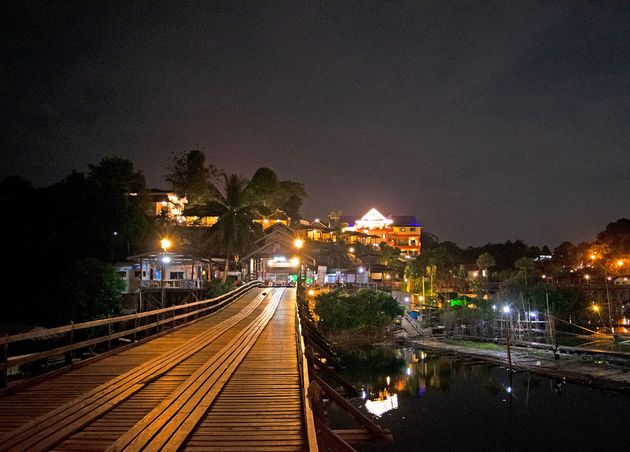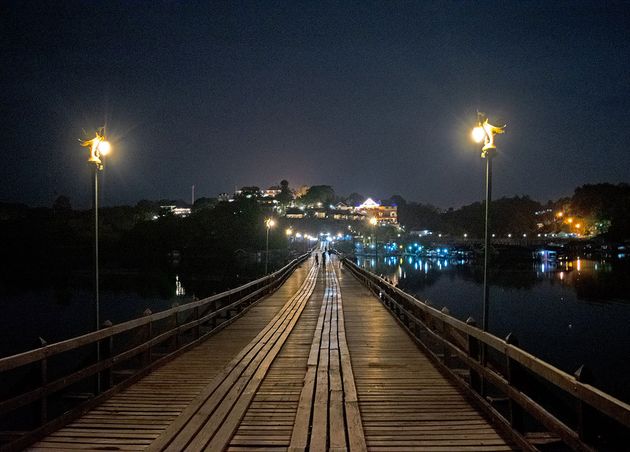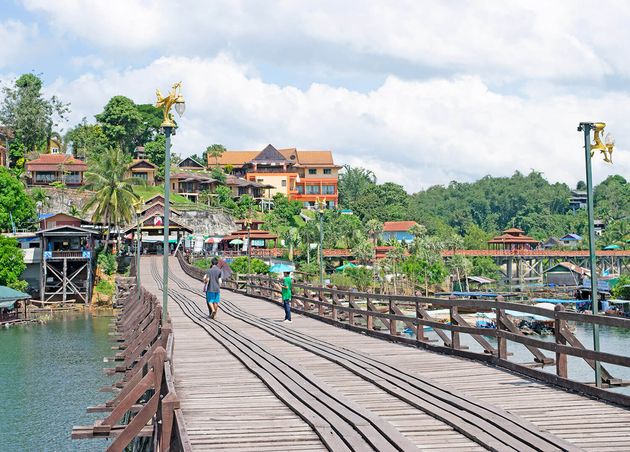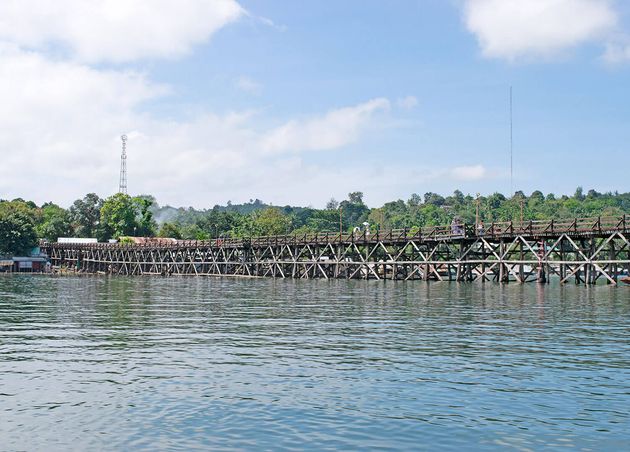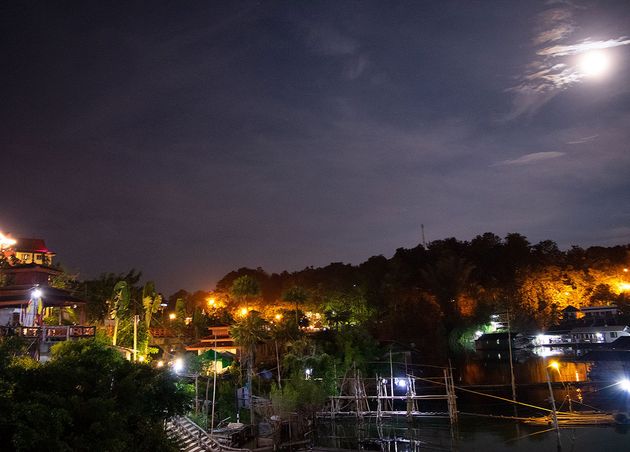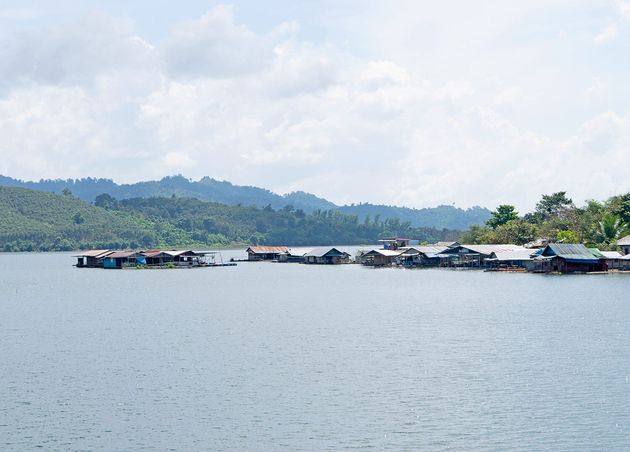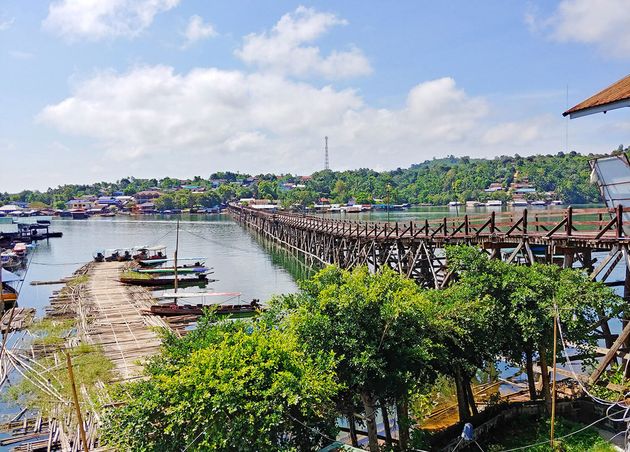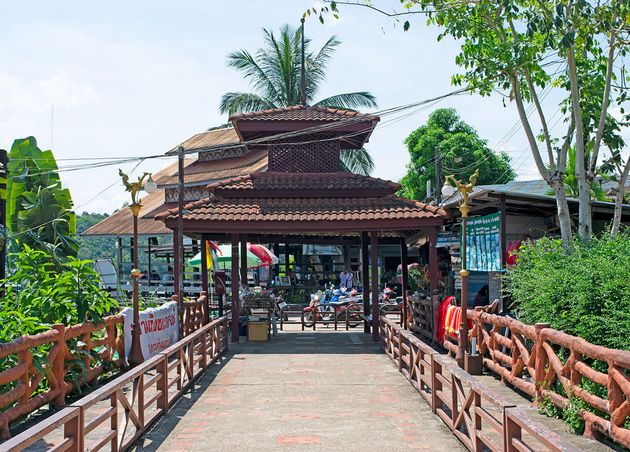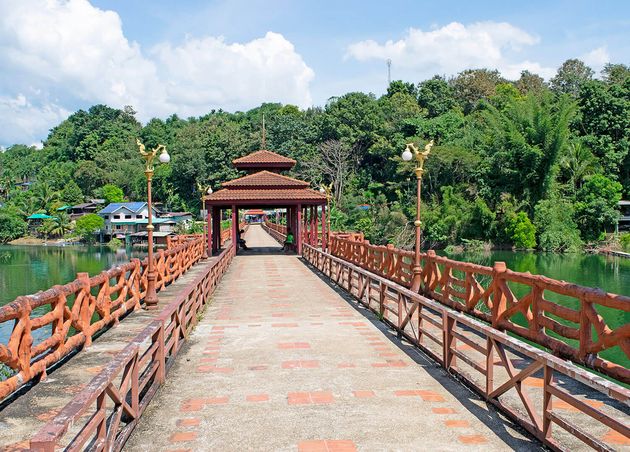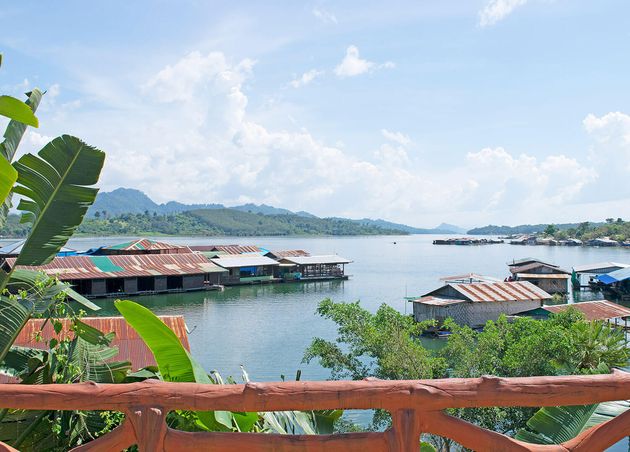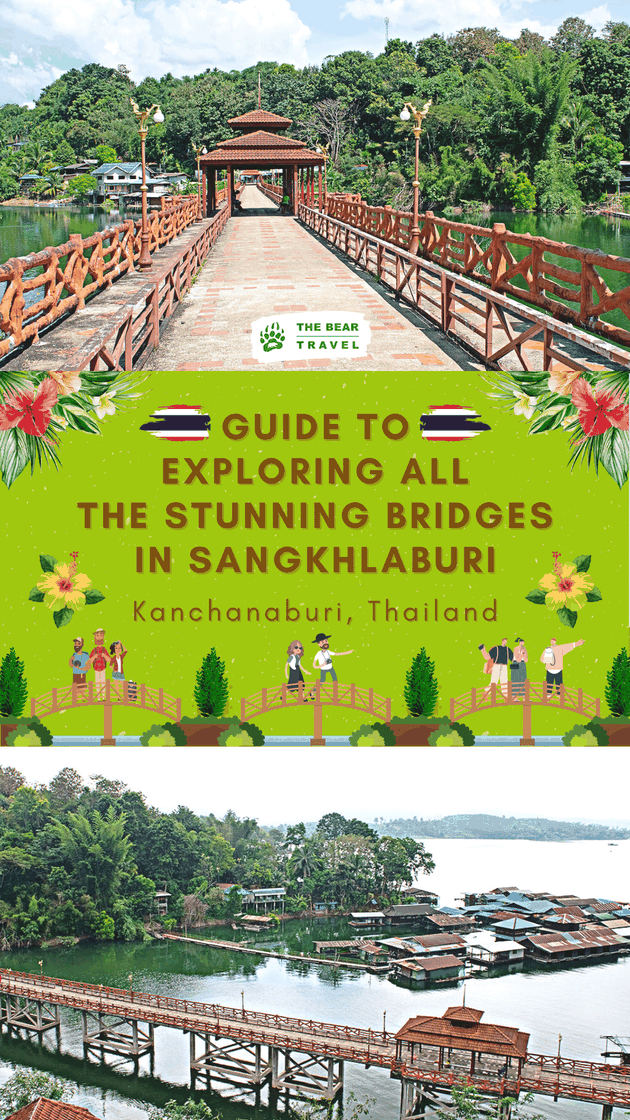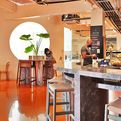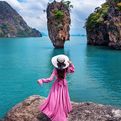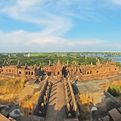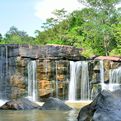Sangkhlaburi: The Complete Guide to Exploring All The Stunning Bridges
Sangkhlaburi is a picturesque town close to the Burmese border, stretching out on both sides of the Songkalia River. One of the main attractions of Sangkhlaburi is the famous wooden bridge, which is believed to be the longest in Thailand, connecting the town's communities on either side of the river. This bridge has significantly fostered peace and mutual understanding between the Mon, Karen, and Thai people living in the area. However, in 2014 the bridge collapsed, prompting the locals to come together and build a temporary floating Bamboo Bridge as a replacement 🎓
Despite its growth and development, Sangkhlaburi has managed to maintain its small village charm, making it a unique and charming district to explore. On weekends, many Thai tourists come to walk across the wooden bridge and stay in the floating houses along the riverbank. However, the town is relatively quiet during the weekdays, providing visitors with a peaceful and serene atmosphere. As Sangkhlaburi is off the beaten path, it remains relatively undiscovered by many travelers, offering a perfect opportunity for those seeking remote, authentic experiences and a variety of off-road adventures.
You may not see many travel blogs recommending Sangkhlaburi as part of their itinerary, which is understandable as it is a bit off the usual tourist trail 🧐 But if you have time and are looking for a more "Thai" experience traveling the country, including its stunning bridges and even boat tours adventures, then I can assure you that you will definitely love Sangkhlaburi 📜
A District with Stunning Bridges to Explore
Sangkhlaburi is a high-altitude district at the end of Thailand, just 25 kilometers from the Burmese border 👨🎓 It has the beautiful Vajiralongkorn Lake (Khao Laem), where most travelers take a boat ride, rest, and enjoy the day, plus plenty of historically and culturally important bridges you shouldn't miss 🧐
Most of the district is covered by dense forests and limestone ranges. Sunken Temple and Temple Wat Mon are two unique and spectacular temples you must visit in the place while enjoying the magical views of the bridges in the area 📜 Most importantly, Sangkhlaburi is a culturally diverse place with Karen, Mon, Thai, and Burmese settlers.
The weather is cool because of the high altitude and the Vajiralongkorn lake, which adds an increased charm to this destination 🎓 It is divided into the Town center and Mon village, which are connected by the second longest hand-made bridge in the world, the 'wooden bridge' 🧐 A seven-hour journey from Krung Thep Maha Nakhon (Bangkok) will get you to this stunning beauty. It remains one of the most favorite tourist attractions of Thailand.
Now, let's further explore the most important and stunning wonders of Sangkhlaburi, the magnificent bridges that you shouldn't miss during your Sangkhlaburi tour 🎓
Saphan Mon Bridge
Saphan Mon Bridge (also known as Uttamanusorn Bridge) is the longest man-made wooden bridge in Thailand and is the second longest wooden bridge in the world after U Bein Bridge in Myanmar 🧐 It is 850 meters long, built across the Songkhalia River for the people of Sangkhlaburi District and the Mon Village to walk across 🎓 The area around the bridge is a beautiful viewpoint of Vajiralongkorn Dam Lake, where you can see the various streams, namely Songkalia, Beekly, and Rantee, that flow together into three experiences. Mon and Thai people in this area use this wooden bridge for their daily commute. Currently, it is one of the famous tourist attractions in Kanchanaburi Province 👨🎓
Mon Bridge is truly the real attraction. The Saphan Mon (in Thai) is a wooden bridge built by the Mon that connects the Thai side of the district to Wangkha the Mon Part 📜 Originally, it was also used by vehicles but is now only a pedestrian bridge. Cars and motorbikes use the concrete bridge a little further 🧐
Sangkhlaburi Mon Bridge is also an exciting place to watch the sunset while dining in the small restaurant at the beginning of the bridge, on the Thai side 🎓
A Deeper Look at Saphan Mon Bridge History
Before the Mon Bridge was built, villagers on both sides of the Songkalia River used the so-called "One Baht Bridge" by using bamboo as a raft 📜 Some people were there to drag the raft connecting each other and used to collect 1 Thai Baht for crossing 🎓 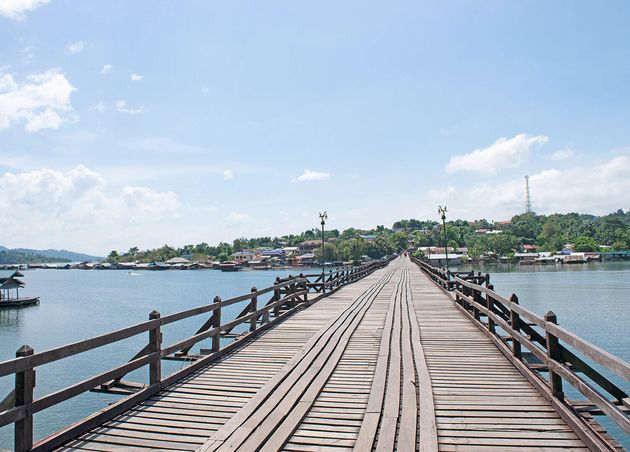
After that, Luang Por Uttama initiated the construction of this wooden bridge to allow villagers to travel across the river easily without cost 👨🎓 The building methods and procedures did not use any machinery; only local types of equipment were used, and villagers who believed in Luang Phor voluntarily helped transport materials, tying them, stumps, pillars, and wooden boards. The wooden bridge was built during the years 1986 - 1987 with a total length of 850 meters across the Songkhalia river with a distance of about 455 meters 🧐
All materials are made of hardwood because of their durability. Part of the timber was taken from the trees that had sunk above the embankment, bridge railing, and the bridge deck. The planks were cut into pieces by the width of the bridge, which is not very wide 📜 The bridge uses 60 pillars in the middle pillar, 10 cubits apart, allowing ships to travel back and forth. The completed bridge connects Moo 2 and Moo 3 of Nong Lu Subdistrict, Sangkhlaburi District 🎓
This wooden bridge is meaningful to the Mon people because it's not just a bridge connecting the villages on both sides of the river but a symbol representing the power of faith towards Luang Phor Uttama 🧐
More Interesting Facts About the Saphan Mon Bridge
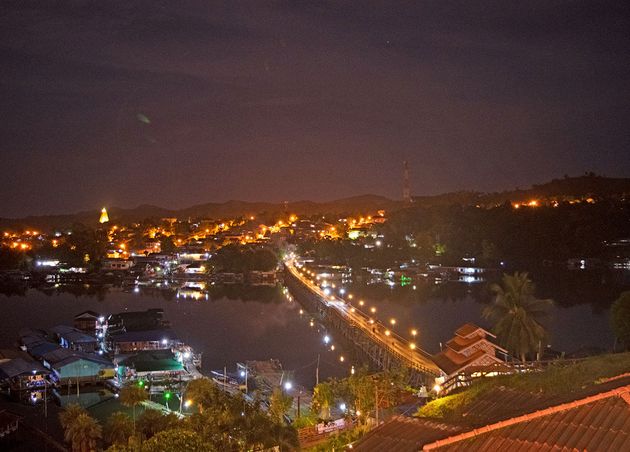
Saphan Mon Bridge is a bridge of faith formed by the cooperation of the communities living in Sangkhlaburi 📜 Every year; tourists come to experience nature while seeing the way of life of the Mon community in this area. Another thing that should not be missed is to take a commemorative photo of the bridge that is the cultural link between the Mon and Thai people on the edge of this country 🎓
Visiting the Saphan Mon Bridge early in the morning is advised, especially from 6:00 AM to 7:00 PM, during which you can see the Mon lifestyle 👨🎓 They offer food to monks every morning. If tourists want to, there is food for sale around Mon village. If they walk across the bank to the Mon village, they can visit the houses in the Mon style to buy souvenirs, or they can stop by to taste Kanom Jeen, banana yak paste, which is a traditional food of Mon people. The Mon’s lifestyle can be seen around the Mon bridge and Mon village 🧐
New businesses are entering society, causing the Mon people's way of life to change according to the new environment that infiltrates the community 📜 But still, some Mon people remain in each family in the Mon village. Most young people are hired to work in the city, so we tend to see the daily life of children and the elderly more than teenagers. Tourists who come to Sangkhlaburi may be able to see some Mon characteristics that are lost in yellow 🎓
The daily routine of Mon people that tourists are very interested in is offering food to monks in the morning 📜 Especially the elderly who wake up early, bring bowls of rice, and sit and wait on the road in a row for the monk alms bowl. Villagers usually offer monks rice and flowers and bow down to the road, which is an impressive sight for tourists 🎓
Tourists who want to make alms can join in the morning offerings with Mon people because there are costumes for monks to sell to tourists. You will see the culture of carrying things on the head of the Mon people. Some people still prefer to carry things on their heads instead of carrying a lot of luggage, and some can carry things very high or heavy and walk fluently 👨🎓 They wear Mon people's traditional dress. Women wear a sarong, a three-quarter sleeveless shirt with a long strip of fabric like a Sabi draped over the shoulder and tied in a bun at the back. At the same time, men like to wear sarongs—Mon people, including children, powder a yellowish tint of Tanaka powder on their faces (Thanaka flour is made from the logs of the rain Thanaka tree and the sandstone pads; you can apply it on the face and spread with a brush) 🧐
Sometimes you will see Mon nuns walking to ask for donations. They wear a Mon-style veil, a pink robe covering the inner cloth in orange, like the color of a monk's robe, with a Sabai across the same color as the inner cloth, holding a tree shade 📜 In summer, the Mon Bridge area is like a water park for children. Children come to play in the clear waters of the Songkalia River and jump from the Mon Bridge 🎓
In the past, the houses of the Mon people were usually built with wooden boards or a bamboo weave lattice 🧐 At present, it has been changed to be built with some mortar. But some houses are still in their original condition to show they are Mon houses. If you notice carefully, Mon houses tend to have a wall on one side that acts as if the excess protrudes like a window porch embossed into a box on the wall of the house. That porch is the monk's room, or the amulet shelf of some houses will decorate that part of the porch beautifully 👨🎓
Songkalia Bridge
Songkalia Bridge has been parallel to the Mon Bridge for a long time. During your Sangkhlaburi journey, you can visit Mon bridge and Khao Laem National Park together 📜 After visiting, if you are thinking of heading back to Sangkhlaburi but before you return your scooter and end the day, drive over to Songkalia Bridge, which parallels the Mon Bridge and offers a great view of the wooden bridge 🧐
From the Songkalia Bridge, you can capture the entirety of the Mon Bridge without having a drone, and I think it is one of the best viewpoints of the Mon Bridge you can get here 🎓 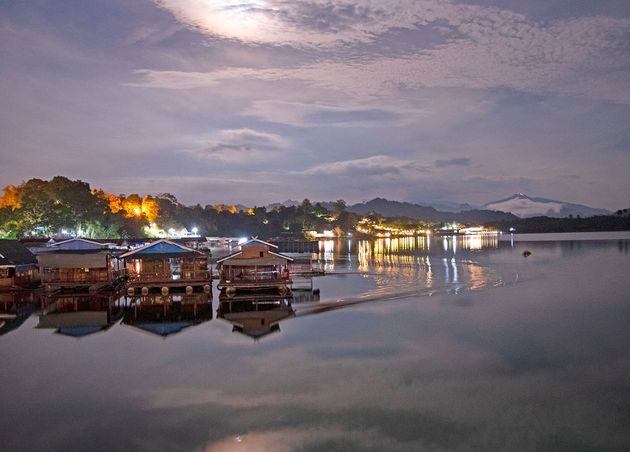
Songkalia River is a river in Kanchanaburi Province, Thailand. It joins with two other rivers, the Beak River and the Rantee River, at a point called Sam Sop or Sam Phrab in Sangkhlaburi District to form the Khwae Noi River. "Song Ka Lia" in the Mon language means "over there" 🧐
It originates from Rocky Creek in the forest of Thung Yai Naresuan on the west side. It flows through a meander in many Karen communities and villages. It is now popular as a destination for kayakers from Songkalia Bridge to Mon Bridge 🎓
The Songkalia River is the center of vitality because life has to be nourished by water. The villagers here are very fond of their birthplace and nature 👨🎓 When you visit; you'll see their bright eyes as they tell you about their hometown.
View the calm Songkalia River from the Songkalia Bridge and the waterfront lifestyle on both sides of the river. It's a fun and relaxing place, especially with kids 🧐 Several restaurants are lined up at the river, with several places to swim or play in the freshwater. During the day, it might get a bit hot, but there are shady places to swim. You may also take a break and relax on the way to the Three Pagodas Pass 📜
🧑🎓 Quick Trivia!
Songkalia is a river that shows the way of life of the Mon, Burmese, Karen, and Thai people.
Rantee Bridge
After passing through steep winding curves, the Rantee Bridge is 15 kilometers from Sangkhlaburi. You can park the car and take a break here because there is also a bathroom in the nearby viewpoint 📜
You can see many houseboats lined in the water below and the simple way of life of the villagers. 🧐 It has a beautiful view with a mountain backdrop, and the white rain clouds will closely follow behind you. So it's the perfect time to take pictures of the scenery.
Rantee River Bridge is also a good resting point during the ascent and descent of the steep mountain as both the driver and the car work hard for a long time 👨🎓 If you come to Sangkhlaburi, try not to miss this unique tourist attraction also for a beautiful view and cool atmosphere. It is also one of the best and most beautiful sunset viewing spots, and it is a place where tourists stop to take photos of rivers and peaks, gorgeous in the area of Sangkhlaburi.🧐
Bamboo Bridge
Built in just 6 days by 500 residents of the Sangkhlaburi district of Thailand, this awesome Bamboo Bridge now spans the Songkalia River 📜
Thailand’s longest Bamboo Bridge was built after the original bridge collapsed due to a build-up of river weeds. Residents of the Sangkhlaburi district used the bridge for their daily commute as communities on both sides trade or work with each other 🧐 So, when the bridge suddenly collapsed, people weren’t able to get across the Songkalia River to go about their daily lives. Something had to be done to solve the problem. And quickly 👨🎓
That’s when residents of the area got together under the supervision of an abbot from a local temple and decided they could build a long bamboo bridge to replace the original bridge, as it would be the fastest and cheapest to build 🎓 Construction of the bridge began as soon as bamboo had been purchased, and six days later, voila, Thailand’s longest bamboo bridge, was completed, floating, functional, and, yes, beautiful 👨🎓 The bridge, by the way, is 850 meters long, including approaches at both sides, and spans the entire way across the 450-meter-wide river. It’s not open for public use yet as local officials have to ensure it’s safe enough to cross, but likely to happen in the next couple of days 📜
Bamboo is used all over Thailand and the rest of Asia, from building scaffolding when skyscrapers are erected to bamboo flooring, fish traps, greenhouse frames, fencing, animal pens, and more 🧐 It’s one of the world’s most robust materials. It grows at a faster rate than it’s inexpensive and environmentally friendly. So, it’s no wonder the people of Sangkha Buri decided to use it for their new bridge 🎓
Red Bridge
Srisuwan Khiri Bridge, or as local people call it as Red Bridge, is located in the Nong lu in the Sangkhlaburi district 🧐 It is a red bridge connected to the wooden bridge in the industrial memorial, the red bridge is on the Thai side. Tourists from other sides can park at Si Suwan and walk on foot to the red bridge, or you can get a motorcycle service 👨🎓
It aims to shorten the distance from the Sangkhlaburi Market to the Mon Bridge. Although it is not a very crowded or popular tourist attraction in Sangklaburi, you can see a good and beautiful view of Mon Bridge from this point and many beautiful views and angles to take pictures of here 📜
You can also see the way of life in Mon village by walking across and over between its side and the market 🧐
🧑🎓 Vocabulary Time!
Diverse
: something that shows a lot of variety and is vastly different could be described as diverse
Reconciliation
: the action of making one view or belief compatible with another
Residents
: refer to individuals who live in a place permanently or for an extended duration
Scaffolding
: the word originates from construction and refers to the temporary platform for builders to stand on while they put up new walls and floors
Vitality
: signifies the state of being strong and active, characterized by high levels of energy
Dr. Theodore (Professor Bear)
Hi! I'm Dr. Theodore Bennet (Professor Bear), your scholarly travel companion who brings history to life with immersive tours and expert guides. With a Ph.D. in History and years of travel writing experience, I offer authoritative insights for unforgettable journeys.
The Bear Travel | Experience like a Local
A fast-growing Thailand Travel Blog written by Expats and Thais since 2017. We will share our experiences and ideas from an insider point of view for you to create your own unique Thailand experience.
For the latest news and events about The Bear Travel, follow us on Facebook, Instagram, Twitter, Pinterest, or YouTube.
For any issues, concerns, or queries, don’t hesitate to CONTACT us.
Recommended for you
Holey Mothership Bakery: Enjoying the Tasty Breakfast in Bangkok
Tle (Hungry Bear)
1 Day in Thailand: How Much Money Do I Need?
Dr. Theodore (Professor Bear)
Ancient City: A Journey Through Time in Samut Prakan
The Bear Team
What does LGBTQ+ Means: A Quick Guide
LGBT Bear
Grocery Shopping in Thailand's Supermarkets: A Guide to Supercenters and More
Dr. Theodore (Professor Bear)


